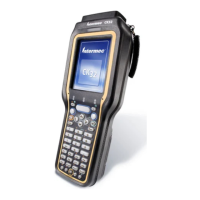Chapter 3 — Configuring the CK32 I-Safe
62 CK32 I-Safe Handheld Computer User’s Manual
WPA runs in 802.1x (Enterprise) mode or PSK (Pre-Shared Key)
mode:
• In Enterprise mode, WPA provides user authentication using
802.1x and an Extensible Authentication Protocol (EAP).
That is, an authentication server (such as a RADIUS server)
must authenticate each device before the device can
communicate with the wireless network.
• In PSK mode, WPA provides user authentication using a
shared key between the authenticator and the CV30. WPA-
PSK is a good solution for small offices or home offices that
do not want to use an authentication server.
To use WPA security, you need:
• an authentication server (Enterprise mode only).
• an access point with an 802.11 b/g radio that supports WPA.
• a CK32 I-Safe with the 802.11b/g radio and the 802.1x/WPA
security option.
The CK32 I-Safe also supports Wi-Fi Protected Access 2 (WPA2)
if you are using Funk security. WPA2 uses an Advanced
Encryption Standard (AES) for data encryption.
WPA2 runs in 802.1x (Enterprise) mode or PSK (Pre-Shared
Key) mode:
• For WPA2-802.1x mode, WPA2 requires authentication in
two phases; the first is an open system authentication and the
second uses 802.1x and an Extensible Authentication
Protocol (EAP) authentication method.
• In PSK mode, WPA2 provides user authentication using a
shared key between the authenticator and the CK32 I-Safe.
WPA2-PSK is a good solution for small offices or home
offices that do not want to use an authentication server.
Using Static WEP Security
The CK32 I-Safe uses the Wired Equivalent Privacy (WEP)
protocol to add security to your wireless network based on the
802.11 standard.

